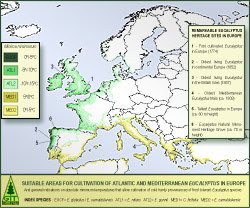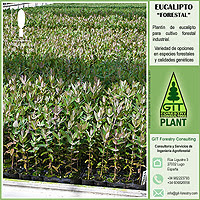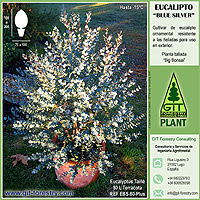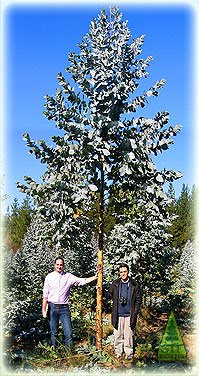Share
Prune Eucalyptus with care, they will be grateful
Or how to avoid unnecesary damage to pruned Eucalyptus
If you decide to give
pruning and/or clipping a go in order to keep your ornamental
Eucalyptus plant size controlled to some extent it is important keeping in mind that, as with any other plant being, secateur wounds require some caution. A first caution is
trying to avoid freezing events affecting recently pruned plants, which can cause bark detachments and further dieback "down the cut". But a second and maybe more important because of less predictable caution has to do with
trying to avoid wound infection by decay fungi.

Some important risk factors for the later have to do with climatic conditions (high humidity, no winds, occasional rains being risky), with plant isolation from infection sources (proximity to other plants or plant based materials susceptible of hosting decay fungi), and of course of the number and intensity of wounds (potential entry points for pathogens).

Many fungi can cause decay on pruned trees, and many are common in fruit trees and other very common ornamental hardwoods in humid temperate gardens. Their spores are released in high humidity conditions and their colonisation of fresh cutting wounds can lead to undesired effects as Silver Leaf, causing dieback on whole shoots and hence an aesthetic nuisance or if a serious case, plant mortality.
Pruning Risk Minimisation for Eucalyptus
Some possible
ways to try to minimise these two risks (frost damage and fungal decay) in ornamental eucalypts are:
- Delaying pruning operations until there is enough safety of harsh freezing events not happening on recently wounded plants
- Trying to delay pruning operations until dry days are more common (depends on the type of spring and rainfall patterns you have), choosing sunny and windy days if possible and better even if it has not rained or been foggy the previous night
- Trying to avoid having favourable environments for fungal growth near the pruned plants (wood debris, sawdust, organic material suitable for the compost bin)
- Monitoring your garden for fungal reproductive organs growing on wood and keeping an eye on them to schedule pruning after the mushrooms are scorched (their spores have been released)
- Applying the protective layer of a good quality pruning wound dressing immediately after cutting, especially in large wounds
- Keeping freshly pruned potted plants outside of the greenhouse until pruning wounds age if these are to be kept in high humidity and warm temperature (+15ºC) conditions and there are potential sources of fungal inoculum nearby
- If the worse happens, removing and destroying infected plant tissue if that is possible without causing new fresh wounds
- If the worse happens and you have more than one specimen plant, observing variation in damage to try to screen individuals with higher tolerance to pathogens
Click to Read Full Story...
Click to Display Summary only...
Share
Some of the most commonly cultivated
Eucalyptus species as garden plants in cold temperate climates are fundamentally chosen because of their
reasonable tolerance to winter frosts. Many of these species, including
Eucalyptus gunnii, can become medium to big sized trees if planted out and left to grow "at their will". However this is not always the desired outcome for tiny gardens, and surely not for pot grown plants in urban "yardless" gardens. Is there something that can be done? Yes.

If the eucalypt species you decide to grow is a
good coppicer (not all of them are), you can try to
train it from the beginning or
convert a plant getting too big sized into a small multistemmed shrub looking like specimen by severely cutting back to almost soil level in the right time of the year. With proper care afterwards the new coppice growth will soon fill up. But perfect symmetrical and compact growth is not always achieved by letting it grow again "at their will". Some training is needed, and this involves trying to get as many branch divisions as possible. One way to do so is
clipping the terminal growth in some branches of your choice, trying to make sure you remove the very top part only and you do that when new lateral branches are already emerging and well visible a bit down each stem. This operation can be repeated along the same growth season two or three (or more) times depending on how fast the growth rate of your plant is (which depends on how much you take care of it, how much light and watering it receives, and fertiliser dosage).
Here you have an
example of a coppiced E. gunnii in a 15 litre pot getting ready for formation pruning. Target is either keeping it as a potted plant for years trying to achieve a
compact outlook or planting it out as a low shrub and keeping it like that at the garden. Not a miniature bonsai but some of its principles also apply here.
Depending on where and when you start training your eucalypt tree the final visual outcome can be different. You can also obtain
medium height globose sculpted trees!Please remember there are some
cautionary measures to take before using secateurs!
Click to Read Full Story...
Click to Display Summary only...



![]() Subscribe to receive EUCALYPTOLOGICS via RSS
Subscribe to receive EUCALYPTOLOGICS via RSS Subscribe to receive EUCALYPTOLOGICS via e-mail
Subscribe to receive EUCALYPTOLOGICS via e-mail


































![Validate my Atom 1.0 feed [Valid Atom 1.0]](http://gus.iglesias.googlepages.com/valid-atom.png)



















